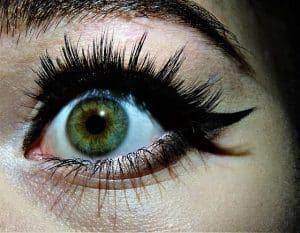Eye Liner, false lashes, & eye health

Makeup and false eyelashes are a huge industry. False lashes alone are projected to be a $1.6 billion dollar industry by 2025. Yet these products are largely unregulated and can have serious consequences for eye health. Specifically, false lashes and eye makeup can contribute to the pathophysiology of anterior blepharitis and result in serious dry eye problems.
These eye beauty products often contain harmful chemicals, some of which induce hypersensitivity (allergic) reactions. Others can even destroy the eyelid’s built-in lubricating oil glands: your meibomian glands. Meibomian Gland dysfunction has been shown to be causative factor in the majority of dry eye disease.
The cosmetics industry is largely unregulated; as result, harmful chemicals such as formaldehyde, parabens, and phthalates are common ingredients in ocular cosmetics. These toxic chemicals are especially common in waterproof makeup. As you may know, waterproof makeup is especially hard to remove, thus prolonging the exposure. This prolonged contact with the skin can result in damage to the delicate structures at the edge of the lid, including the lash follicles and meibomian glands.
Poor health habits can be exacerbated by use of eye makeup and lashes
The makeup applicators and brushes are often not cleaned properly or discarded in a timely manner. This can lead to contamination by harmful bacteria, fungi, or Demodex mites. Patients who wear false lashes often do not adequately remove cosmetics for fear that their lashes will fall off prematurely. These habits can exacerbate blepharitis (a bacterial or mite infestation of the lids or lashes) and make treatment more challenging. Makeup along the waterline (eyeliner) can physically plug the pores of the meibomian glands, contributing to dry eye and potentially increasing the risk of stye development.
Dry eye disease is known to affect over 16 million Americans, and the majority of them have lid margin disease. Eyeliner, waterproof mascara, and false lashes (and the associated glues that sometimes get on the lid or IN the eye) are contributing to this problem.
What can be done to make using eye cosmetics safer?
We are not proposing that all patients stop using cosmetics entirely. While we are not a big fan of false lashes after seeing related damage and scarred lids, they can be relatively safe when carefully (professionally) applied. Using Latisse to grow your own long lashes is certainly safer than false lashes. Ideally all patients put eye liner on the outer edge of their lash line, not on the ‘eye side’ of the lashes or the “water line” where the meibomian glands are releasing eye-lubricating oils. Avoiding ‘water proof’ cosmetic formulations will help keep patients safer. Clinique is a brand that strives to be hypo-allergenic. Eye-friendly product lines such as Eyes Are The Story can actually improve appearance of the eyes by reducing inflammatory reactions.
At-home lid health routines should involve removing makeup (try iVizia lid wipes), soaping up the lids and lashes with mild soap in the shower, and maybe the use of NuLids. Cannon EyeCare offers in-office deep cleanings with the NuLids device. In-office cleanings are not covered by insurance but nevertheless are an effective and efficient common-sense intervention for patients with blepharitis.
Blepharitis and dry eye are chronic in nature and require ongoing patient participation in the form of self-care. Long-term maintenance is much healthier and leads to better outcomes than waiting for a crisis to arise, and then asking your eye doctor to solve it.

Makeup and false eyelashes are a huge industry. False lashes alone are projected to be a $1.6 billion dollar industry by 2025. Yet these products are largely unregulated and can have serious consequences for eye health. Specifically, false lashes and eye makeup can contribute to the pathophysiology of anterior blepharitis and result in serious dry eye problems.
These eye beauty products often contain harmful chemicals, some of which induce hypersensitivity (allergic) reactions. Others can even destroy the eyelid’s built-in lubricating oil glands: your meibomian glands. Meibomian Gland dysfunction has been shown to be causative factor in the majority of dry eye disease.
The cosmetics industry is largely unregulated; as result, harmful chemicals such as formaldehyde, parabens, and phthalates are common ingredients in ocular cosmetics. These toxic chemicals are especially common in waterproof makeup. As you may know, waterproof makeup is especially hard to remove, thus prolonging the exposure. This prolonged contact with the skin can result in damage to the delicate structures at the edge of the lid, including the lash follicles and meibomian glands.
Poor health habits can be exacerbated by use of eye makeup and lashes
The makeup applicators and brushes are often not cleaned properly or discarded in a timely manner. This can lead to contamination by harmful bacteria, fungi, or Demodex mites. Patients who wear false lashes often do not adequately remove cosmetics for fear that their lashes will fall off prematurely. These habits can exacerbate blepharitis (a bacterial or mite infestation of the lids or lashes) and make treatment more challenging. Makeup along the waterline (eyeliner) can physically plug the pores of the meibomian glands, contributing to dry eye and potentially increasing the risk of stye development.
Dry eye disease is known to affect over 16 million Americans, and the majority of them have lid margin disease. Eyeliner, waterproof mascara, and false lashes (and the associated glues that sometimes get on the lid or IN the eye) are contributing to this problem.
What can be done to make using eye cosmetics safer?
We are not proposing that all patients stop using cosmetics entirely. While we are not a big fan of false lashes after seeing related damage and scarred lids, they can be relatively safe when carefully (professionally) applied. Using Latisse to grow your own long lashes is certainly safer than false lashes. Ideally all patients put eye liner on the outer edge of their lash line, not on the ‘eye side’ of the lashes or the “water line” where the meibomian glands are releasing eye-lubricating oils. Avoiding ‘water proof’ cosmetic formulations will help keep patients safer. Clinique is a brand that strives to be hypo-allergenic. Eye-friendly product lines such as Eyes Are The Story can actually improve appearance of the eyes by reducing inflammatory reactions.
At-home lid health routines should involve removing makeup (try iVizia lid wipes), soaping up the lids and lashes with mild soap in the shower, and maybe the use of NuLids. Cannon EyeCare offers in-office deep cleanings with the NuLids device. In-office cleanings are not covered by insurance but nevertheless are an effective and efficient common-sense intervention for patients with blepharitis.
Blepharitis and dry eye are chronic in nature and require ongoing patient participation in the form of self-care. Long-term maintenance is much healthier and leads to better outcomes than waiting for a crisis to arise, and then asking your eye doctor to solve it.
Pike Place Office
1906 Pike Pl Unit 8-b,
Seattle, WA 98101
University Village Office
2602 NE University Village St,
Seattle, WA 98105
Pike Place Office Hours
Monday
Closed
Tuesday
10:00 am - 5:00 pm
Wednesday
Closed
Thursday
10:00 am - 5:00 pm
Friday
10:00 am - 5:00 pm
Saturday
10:00 am - 5:00 pm
Sunday
Closed
University Village Office Hours
Monday
10:00 am - 6:00 pm
Tuesday
10:00 am - 6:00 pm
Wednesday
10:00 am - 6:00 pm
Thursday
10:00 am - 6:00 pm
Friday
10:00 am - 6:00 pm
Saturday
10:00 am - 6:00 pm
Sunday
Closed
